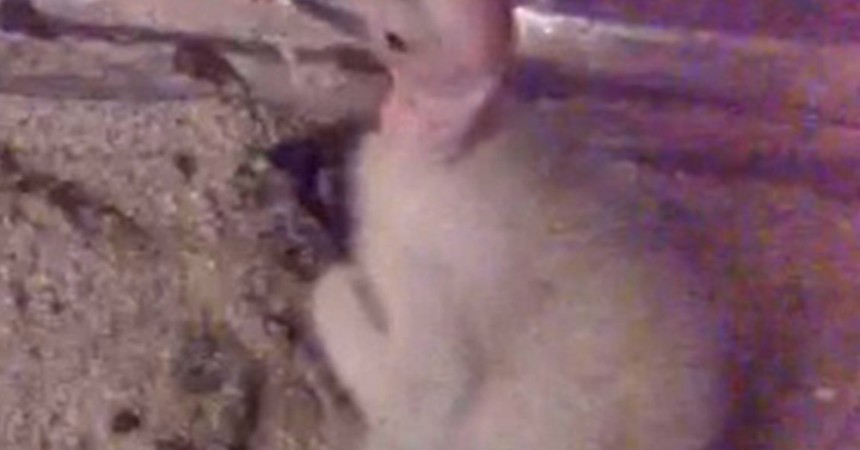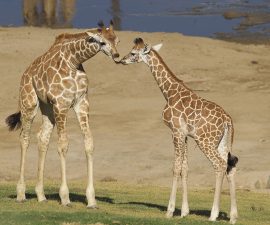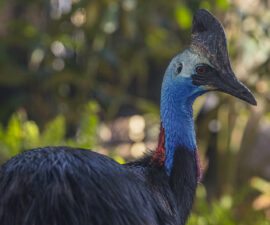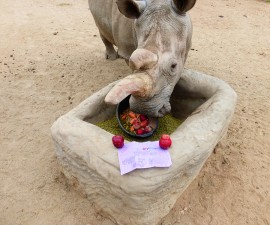Welcome back to the San Diego Zoo Safari Park’s Condor Cam! The live-streaming camera provides a rare look into an active California condor nest. Over the next five months, you will be able to witness our newest California condor chick grow, develop, and eventually fledge (leaving of the nest).
Another exciting California condor breeding season is upon us. Our first egg of the season was laid on 13 February 2015. The proud parents are Sisquoc (pronounced “SISS-kwawk”) and Shatash (pronounced “shah-TAWSH”). Sisquoc is the male, and he is wearing yellow wing tags (#28). Shatash, the female, is not wearing any wing tags. Also, Sisquoc is visibly larger than Shatash. He is the largest California condor here at the Park, weighing in at 25 pounds.
Sisquoc was the first California condor ever hatched in a zoo (his egg was laid in the wild and brought to the San Diego Zoo for incubation). He emerged from his shell on 30 March 1983, and news of his hatching triggered an outpouring of mail from all over the world. Congratulatory letters were sent by conservationists, zoos, governments, school classrooms, and many individuals, all wanting to help with the condor project.
Shatash hatched at the Los Angeles Zoo, one of our valuable partners in the California Condor Recovery Program. Her father was the first condor to hatch at the San Diego Zoo Safari Park (again, from a wild-laid egg), back in 1985. Sisquoc and Shatash have been paired together since 1993. This is their 24th egg. Seventeen chicks have hatched, and Sisquoc and Shatash have raised six of them themselves, including two chicks on CondorCam: Saticoy, who is flying free in southern California, and Cuyamaca, who was released in Arizona. The other chicks were raised by keepers who used a condor puppet so the chicks wouldn’t imprint on their human caretakers. Sisquoc and Shatash have proven to be great and reliable parents.

For the last few years, we have been fortunate to be able to show the condor chicks hatching live on CondorCam. This year was a little different. Sisquoc and Shatash’s egg had some complications during incubation. Early on, we saw signs that the embryo might be in the wrong position inside the egg. We call this a “malposition.” A chick should be in a certain position in order to hatch: its tail should be in the pointy end of the egg and the head should be tucked under the right wing and oriented toward the air cell. The air cell is a pocket of air at the big end of the egg. Next time you crack open a chicken egg at home, look for the air cell.
Our early observations proved to be accurate. After taking the egg to our Harter Veterinary Center for radiographs, we were able to confirm that the chick was upside-down in the shell. This is not always a lethal malposition, but it did give us some concern. Think of it like a breech birth for mammals.
A small hole was drilled in the large end of the egg, and then the egg was propped at an angle in an incubator with the chick’s head angled upward. When the weight of the chick’s body caused it to break through the air cell membrane, the chick settled into the big end of the egg, thanks to the drilled hole. The movement downward into the shell provided the chick with more space and air in the small end of the egg where its head was located. This procedure allowed the chick an opportunity to continue the hatching process on its own, without any invasive procedures on our part.
Much to our relief, the chick broke through the shell – or “pipped” – on its own on April 9! The pip was in a really good spot, considering its upside-down position, and was nice and strong. We returned the pipped egg to the parents at around noon on the same day. We quietly snuck into the nest box while they were out eating in their flight pen to exchange the pipped egg for the artificial egg that they had been tending to while we incubated their real one. Shatash returned to the nest and settled back onto her hatching egg.
Happily, the egg hatched with no complications on April 11 at 1:01 p.m.
California condors tend to be monogamous and share ALL nest duties: incubating the egg, brooding the chick, feeding the chick, and defending the nest. Sisquoc and Shatash will take turns tending to the chick.
Sisquoc and Shatash’s new chick is very valuable to the condor population. California condors are critically endangered. In 1982, they were on the road to extinction, with only 22 birds in the world. Today, through breeding programs at the San Diego Zoo Safari Park, the Los Angeles Zoo, the Oregon Zoo, and the World Center for Birds of Prey (in Boise, Idaho), as well as intensive field management in the wild, the population is over 430 birds. It’s a nice population increase, but there is still a lot of work that needs to be done. This chick represents the next step in the California condor story – and you get to witness it on Condor Cam!
Stay tuned for future weblogs describing the growth and development of our new chick. If you have any questions about what you’re seeing, feel free to ask them in the “Comments” section at the end of this post, and we’ll do our best to provide answers. Happy viewing!
Ron Webb is a senior keeper at the San Diego Zoo Safari Park. Read his previous post, California Condor Breeding Season.





